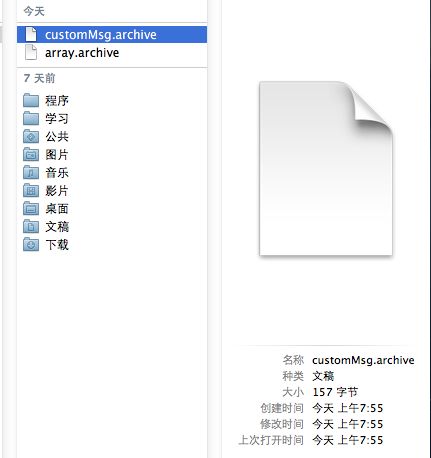Objective-c中对象的归档
对象的归档是指将对象写入文件保存在硬盘上,当再次挡开程序的时候,可以还原这些对象。对象的归档也叫对象的序列化或对象的持久化
数据的持久性保存的方式:
1、对象归档NSKeyedArchiver
2、NSUserDefaults
3、属性列表化(NSArray,NSDictionary)
4、SQLite数据库、Core Data数据库
归档的形式:
1、对Foundation库中对象进行归档 2、自定义对象归档,自定义对象进行归档需要实现归档协议NSCoding
1、下面来实现第一种形式的归档,实现数组的序列化与反序列化
归档
//实现一个数组的序列化与反序列化
NSString *homeDirectory = NSHomeDirectory();//获取用户的根目录
NSArray *array = @[@123,@456,@"789",@"88888"];
NSString *drectory = [homeDirectory stringByAppendingPathComponent:@"array.archive"];
BOOL isSuccess = [NSKeyedArchiver archiveRootObject:array toFile:drectory];
if(isSuccess){
NSLog(@"成功序列化........");
}
解档
//解归档,反序列化
NSArray *array1 = [NSKeyedUnarchiver unarchiveObjectWithFile:drectory];
NSLog(@"%@",array1);
使用这种方法的归档的缺点是每个对象都要归档一个文件,对象多归档的文件也多,
自定义内容归档( 该种方法的归档使用的更方便)
归档
使用NSData实例作为作为归档的存储数据
添加归档的内容(设置key与value)
完成归档
将归档数据存入磁盘中
解归档
从磁盘读取文件,生成NSData实例
根据Data实例创建和初始化解归档实例
解归档,根据key访问value的值
//归档
NSString *homeDirectory = NSHomeDirectory();
NSString *filePath = [homeDirectory stringByAppendingPathComponent:@"customMsg.archive"];
NSMutableData *data = [NSMutableData data];
NSKeyedArchiver *archiver = [[NSKeyedArchiver alloc]initForWritingWithMutableData:data];
[archiver encodeInt:1000 forKey:@"num"];
[archiver encodeObject:@"jimGreen" forKey:@"name"];
[archiver finishEncoding];
[archiver release];
[data writeToFile:filePath atomically:YES];

//解归档
NSData *myData = [NSData dataWithContentsOfFile:filePath];
NSKeyedArchiver *unarchiver = [[NSKeyedUnarchiver alloc]initForReadingWithData:myData];
int num = [unarchiver decodeIntForKey:@"num"];
NSString *name = [unarchiver decodeObjectForKey:@"name"];
NSLog(@"name id %@,age is %d",name,num);
2、自定义对象归档
自定义的对象要支持归档,需要实现NSCoding协议,NSCoding协议有两个方法encodeWithCoder方法对对象的属性数据进行编码处理,initWithCoder解码归档数据来初始化对象。
实现NSCoding协议后就能用NSKeyedArchiver就行归档。
下面看个例子:
对User类进行解归档
.h文件
#import <Foundation/Foundation.h> @interface User : NSObject<NSCoding> @property(nonatomic,copy)NSString *name; @property(nonatomic,copy)NSString *email; @property(nonatomic,copy)NSString *password; @property(nonatomic,assign)int age; @end
.m文件
#import "User.h"
@implementation User
//对属性进行编码,归档的时候会调用
-(void)encodeWithCoder:(NSCoder *)aCoder{
[aCoder encodeInt:_age forKey:@"age"];
[aCoder encodeObject:_email forKey:@"email"];
[aCoder encodeObject:_name forKey:@"name"];
[aCoder encodeObject:_password forKey:@"password"];
}
//对属性进行解码,解档的时候会用
-(id)initWithCoder:(NSCoder *)aDecoder{
if(self = [super init]){
_age = [aDecoder decodeIntForKey:@"age"];
self.name = [aDecoder decodeObjectForKey:@"name"];
self.email = [aDecoder decodeObjectForKey:@"email"];
self.password = [aDecoder decodeObjectForKey:@"password"];
}
return self;
}
//该方法是当在以%@格式打印对象的时候调用
-(NSString *)description{
NSString *str = [NSString stringWithFormat:@"name is %@,age id %d,email is %@,password id %@",_name,_age,_email,_password];
return str;
}
-(void)dealloc{
[_password release];
[_email release];
[_name release];
[super dealloc];
}
@end
User *user = [[User alloc]init];
user.age = 24;
user.name = @"jim Green";
user.email = @"[email protected]";
user.password = @"123456";
NSString *path = [NSHomeDirectory() stringByAppendingPathComponent:@"user.archive"];
BOOL isSuccess = [NSKeyedArchiver archiveRootObject:user toFile:path];
if (isSuccess) {
NSLog(@"成功!");
[user release];
//自定义对象的解归档
}
解档
User *user = [NSKeyedUnarchiver unarchiveObjectWithFile:path];
NSLog(@"%@",user);



